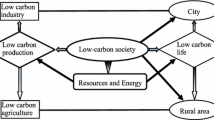Abstract
Low carbon economy regards economic system as an integral part of natural world, and its goal is through reducing and saving materials (minus materialization such as energy saving, consumption cut and greenhouse gas emission reduction) to realize harmonious development between man and nature to create a higher standard of living, better quality of life and more opportunity for development for people. Therefore, low carbon economy is a new economic development pattern, philosophy and way of subverting traditional economy and is an important impetus for economic and social development. How to develop low carbon economy is an economic and technical issue as well as a political issue. In the context of globalization, it is a great economic game in the world, and only the country taking an advantage in this game will be able to win a greater space and a better opportunity for development. Clearly, low carbon economy represents the future direction and trend of economic development, and it is the basis and condition of realizing sustainable development.
Similar content being viewed by others
References
Bao, J. Q., Miao, Y., & Chen, F. (2008). Low carbon economy: New change of human economic development way. China Industrial Economy, 4, 153–160.
Bartelmus, P. (2008). Quantitative economics: How sustainable are our economies? (pp. 39–43). Secaucus NJ, Heidelberg: Springer Science and Business Media.
Ding, Y. H. (2008). The climate change: A challenge for China. In K. M. Zhang, J. H. Pang, & D. P. Cui (Eds.), On the low carbon economy (pp. 5–15). Beijing: China Environmental Science Press.
Dou, X. S. (2002). On the mode of economic growth. Financial Research, 3, 9–13.
Dou, X. S. (2007). An analysis of international capital flows and macroeconomic operation. Beijing: China Financial and Economic Press.
Dou, X. S. (2013a). Low carbon economy development: China’s pattern and policy selection. Energy Policy, 63, 1013–1020.
Dou, X. S. (2013b). Low carbon economy development: China’s road and policy choice. Journal of Management and Sustainability, 3, 95–114.
Dou, X. S., & Zhao, S. S. (2014). The objective, mechanism and pathway of low carbon agriculture development in China. Mitteilungen Klosterneuburg, 64(4), 475–495.
Ellerman, A. D. (2002). Designing a tradable permit system to control SO2 emissions in China: Principle and practice. The Energy Journal, 23(2), 1–26.
Feng, Z. J. (2009). Reflects on the low carbon economy. China Soft Science, 12, 18–23.
Fu, Y., Ma, Y. H., Liu, Y. J., & Niu, W. Y. (2008). Study of low carbon economic development mode. Chinese Population, Resource, and Environment, 3, 14–19.
Hanson, D. A., et al. (2006). Technology policy and world greenhouse gas emissions in the AMIGA modeling system. The Energy Journal, 27(Special Edition), 355–371.
Jiang, K. J. (2008). “Low carbon” is a better way of life. In K. M. Zhang, J. H. Pang, & D. P. Cui (Eds.), On the low carbon economy. Beijing: China Environmental Science Press.
Jin, Y., & de Swaan Arons, J. (2009). Resource, energy, environment and social–scientific and engineering principles for circular economy. Beijing: Chemical Industry Press.
Jonathan, K., et al. (2006). Combining energy technology dynamics and macroeconometrics: The E3MG model. The Energy Journal, 27(Special Edition), 113–133.
Li, J. F., & Ma, L. J. (2008). Low carbon economy is a new rule to regulate development pattern of world. In K. M. Zhang, J. H. Pang, & D. P. Cui (Eds.), On the low carbon economy. Beijing: China Environmental Science Press.
Liu, X. L. (2009). Low carbon economy and the development of human society. Bright Daily (theory edition), April 21.
Murphy, F. H., et al. (2006). Allocating the added value of energy policies. The Energy Journal, 27(2), 143–156.
Parry, W. H. I., et al. (2002). Early emission reduction programs: An application to CO2 policy. The Energy Journal, 23(1), 73–95.
Reyer, G., & Zwaan, B. V. (2004). A sensitivity analysis of timing and costs of greenhouse gas emission reductions. Climate Change, 65, 39–71.
The Ministry of Environmental Protection. (2011). Guidance on the environmental protection system to further promote the development of environmental protection industry ([2011] No. 36). Retrieved from http://baike.baidu.com/view/493354.htm.
Toshihiko, M., et al. (2006). Assessment of CO2 reductions, and economic impacts considering energy-saving investment. The Energy Journal, 27(Special Edition), 175–283.
UK government. (2003). Our energy future, creating a low carbon economy. UK Energy White Paper.
Wang, T. (2008). The future of low carbon economy in China. In K. M. Zhang, J. H. Pang, & D. P. Cui (Eds.), On the low carbon economy. Beijing: China Environmental Science Press.
Xin, J. J., Hong, D., & Zhao, G. (2010). Report on low carbon economy. Beijing: Electronics Industry Press.
Zhang, S. Q. (2008). Low carbon economy: The bridge of linking regional pollution control, climate change mitigation and sustainable development. In K. M. Zhang, J. H. Pang, & D. P. Cui (Eds.), On the low carbon economy. Beijing: China Environmental Science Press.
Zhen, Z. N., & Li, D. S. (2003a). The clean development mechanism: A new international environmental cooperation mechanism. Energy Saving and Environmental Protection, 4, 10–13.
Zhen, Z. N., & Li, D. S. (2003b). The clean development mechanism: A new international environmental cooperation mechanism. Energy Saving and Environmental Protection, 5, 8–11.
Zhuang, G. Y. (2005). The way and potential analysis of China’s low-carbon economic development. Pacific Journal, 11, 79–81.
Acknowledgments
This research was funded by research Grant (10XJY004) from the National Social Science Foundation of China. The author appreciates generous support from the funds. The constructive comments of two anonymous reviewers are thankfully acknowledged.
Author information
Authors and Affiliations
Corresponding author
Rights and permissions
About this article
Cite this article
Dou, X. The essence, feature and role of low carbon economy. Environ Dev Sustain 17, 123–136 (2015). https://doi.org/10.1007/s10668-014-9542-9
Received:
Accepted:
Published:
Issue Date:
DOI: https://doi.org/10.1007/s10668-014-9542-9




